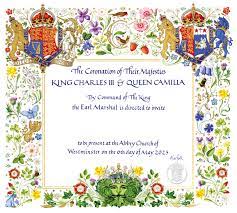
The invitations to the coronation of King Charles III have been made public and what stands out the most is the wording upon it.
Rather than guests being invited to the event on 6 May for King Charles and the “Queen Consort”, it reads instead “the coronation of their majesties King Charles III and Queen Camilla”, confirming that the ceremony will be the official marking of how Camilla will be titled moving forward.
The illustrated invite, printed on recycled paper, has been sent to approximately 2,000 people, along with a new official photo of the royal couple.
They have been produced by Andrew Jamieson, a heraldic artist and manuscript illustrator, who has created a deeply ornate and detailed design, which among others features an ancient figure from British folklore, emblematic flowers, coats of arms, and symbolic animal drawings.
The change in Camilla’s title will not be met with universal approval as it goes against what was seemingly Her Majesty Queen Elizabeth II’s “sincere wish” for her daughter-in-law to be officially recognised as “Queen Consort”.
Invitation’s wording
The actual text of the invitation reads: “The Coronation of Their Majesties King Charles III & Queen Camilla / by Command of the King / the Earl Marshal is directed to invite [BLANK SPACE] to be present at the Abbey Church of Westminster on the 6th day of May 2023”
Not what Queen Elizabeth II wished for
It is being suggested by sources close to Buckingham Palace that whilst in the initial part of the King’s reign it made sense to use “Queen Consort” as a way of distinguishing Camilla from Elizabeth II, the coronation represented an “appropriate time” to officially change to “Queen Camilla”.
The only issue with that statement however, is that it seems to contradict the expressed wishes of the late Queen. It does appear that what was envisaged by Her Majesty, is now being conveniently disregarded.
“Cumbersome” title?
The royal couple have been married for 18 years and Queen Elizabeth II was extremely supportive of Camilla throughout, particularly last year with her public endorsement of the use of the title “Queen Consort” which came at a time when it was still being suggested that she should be referred to, when the time came, as Princess Consort.
For whatever reason, things now have changed and the decision has been taken, so Queen Camilla it shall be. A view from a royal commentator is that the title “Queen Consort” is a little too “cumbersome” but seemingly nobody thought to approach the matter with Her Majesty Queen Elizabeth II, when she made it clear what her wishes were.
The symbolic Green Man
Mr Jamieson is a Brother of the Art Workers’ Guild, of which King Charles is an honorary member. Back in 2011 he illuminated the Royal Letters Patent issued under the Great Seal of the Realm, issuing Prince William with his Duke of Cambridge wedding day title.
The ancient figure which he has prominently placed at the foot of the invites is the head of “The Green Man”. The figure is said to be symbolic of spring and rebirth and can actually be found in many forms throughout history, with an air of mystery surrounding it, carvings are commonly found in churches across Europe; it has been described as being a bridge between Pagan and Christian beliefs.
Wildly colourful bordering
The invitations with their elaborately decorated artwork and gold foil detailing, are also crowned in natural foliage and formed of leaves of oak, ivy and hawthorn; plus the the UK’s emblematic flowers: the Tudor Rose of England; The Thistle of Scotland; the Clovers (or Shamrock) of Northern Ireland; and the Yellow Daffodil of Wales.
In addition there is a colourful abundance of British wildflower around the border, including the late Queen’s favourite, Lily of the Valley which represents happiness; cornflowers signifying hope and anticipation; wild strawberries which are part of a beloved royal dessert; dog roses for love and beauty; bluebells demonstrating humility and gratitude; and a sprig of rosemary as a show of remembrance, possibly in memory of both of the Kings parents.
The flowers are deliberately arranged in groups of three, in a nod to Charles becoming the third monarch of the name.
Wildlife is also represented in the form of a bee, a butterfly, a ladybird, a wren, and a robin. Bees have long been associated with the royal family and there is a long held tradition where the royal bee-keeper informs the hive when the monarch dies. Butterflies are often thought to represent rebirth and new beginnings, as are wrens and robins; whilst ladybirds are said to symbolise good fortune.
The King and Queens arms
In the top left of the invitation is King Charles’ coat of arms, which features the three Lions of England, a single rampant Lion of Scotland, the three Lions once again, and then a stringed Argent as a representation of Ireland, together with a standing unicorn.
In the opposite corner is Camilla’s coat of arms, which has both the royal lion and her father Major Bruce Shand’s bear. Added to it recently has been the Garter, which followed her installation as a Royal Lady of the Order of the Garter in June of last year.
Designer’s career defining achievement
Mr Jamieson, who is illuminator and scribe for the king’s Crown Office in London, was thrilled to be asked to create the invites. He commented that in being able to play a small part in such an historic event in the nation’s history had been an “incredible honour and the opportunity of a lifetime”, describing it as “the pinnacle of my career,” before wishing the royal couple “every good wish for their upcoming Coronation celebration.”
No show from the president
An early response came from US President Joe Biden, who telephoned King Charles III personally to inform him that he will not be attending, but assured him that First Lady Jill Biden would be his representative.
Still no commitment from Harry
The one invite everyone is waiting to discover the response from is that of the Duke and Duchess of Sussex, with the King’s youngest son still not showing his hand, even with the coronation of his father just four weeks away.
Record breakers
Charles and Camilla will become the eldest crowned King and Queen (Consort) in British history. Currently the records stand with King William IV, who ascended the throne in 1830, at the tender age of 64 and Queen Alexandra who was crowned Queen Consort aged 58, in 1902.
King Charles III passes the record by ten years, whilst Camilla is 17 years older at 75 years old.













0 Comments